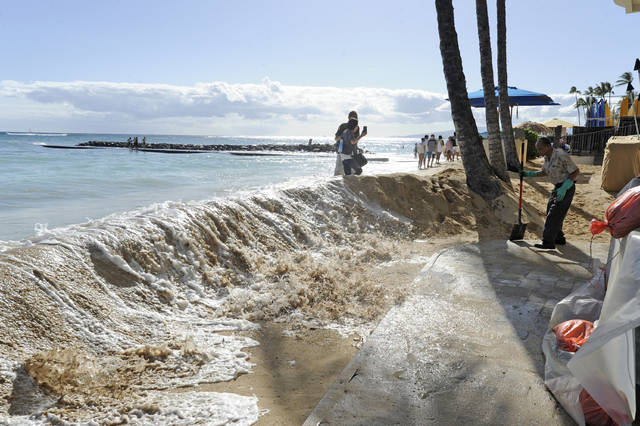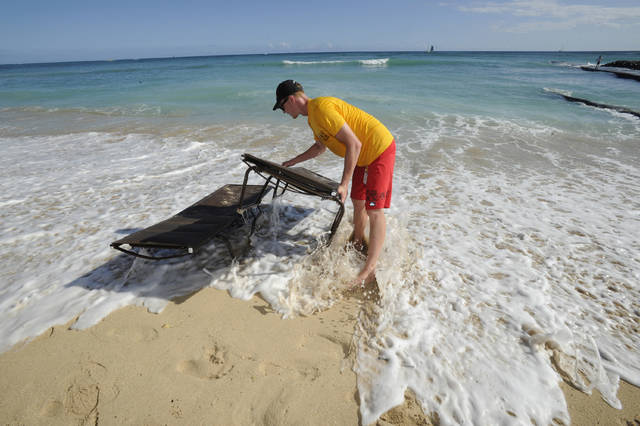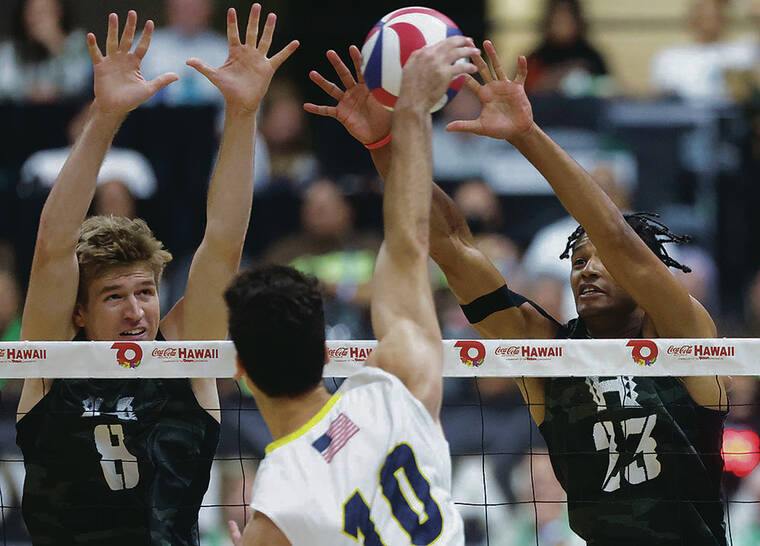King tide, south swell promise a wet wallop

BRUCE ASATO / BASATO@STARADVERTISER.COM
A large wave washed over a 3-4 foot tall berm on the beach in front of the Outrigger Reef Waikiki Beach Hotel on Thursday as tourists tried to avoid getting wet and a hotel employee paused in his cleaning sand from the area. The berm was constructed in the hope of keeping the high waves from the king tide from washing into the hotel.

BRUCE ASATO / BASATO@STARADVERTISER.COM
Cole Nordquist of Waikiki Shore Beach Service on Thursday collected lounge chairs that were set up on the sand earlier on the beach in front of the Outrigger Reef Waikiki Beach Hotel. The rising king tide waters washed up to the chairs in the afternoon.

BRUCE ASATO / BASATO@STARADVERTISER.COM
Robert McConnell, general manager of the Outrigger Reef Waikiki Beach Hotel, middle, stood at a barrier at one of the stairways that lead from the beach to the Shorebird Restaurant and Beach Bar at the hotel. The hope is that the barrier will absorb the impact of the high waves.



Honolulu is bracing for some of its highest tides in more than a century in a rare event scientists describe as a test-run for a future of rising sea levels.
The city’s Department of Parks and Recreation placed more than 500 sandbags along the makai side of Ala Moana Beach Park and over 200 sandbags at Kuhio Beach Park in Waikiki on Thursday in preparation for the first onslaught of this summer’s king tides.
Additionally, hotels along Waikiki Beach and other oceanfront properties around the island prepared for water levels up to 1 foot higher than normal.
The so-called king tide will receive an extra push today and Saturday from high surf along south-exposed shores. The National Weather Service has issued a high-surf advisory with waves expected to be 3 to 5 feet this morning, climbing to as high as 10 feet this afternoon.
Today’s peak tide is forecast for 5:06 p.m., while Saturday’s peak will be at 5:54 p.m.
Mayor Kirk Caldwell said Thursday that officials are unsure of how much effect the high surf will have on coastal properties, but they want people to be prepared.
Don't miss out on what's happening!
Stay in touch with breaking news, as it happens, conveniently in your email inbox. It's FREE!
Meanwhile a group of scientists met at the shore at about 4 p.m. Thursday near Fort DeRussy Park to observe the king tide, a phenomenon caused by an unusual combination of temporary and ongoing rising sea levels, along with the highest tides of the year.
This summer’s king tides are expected to hit during the last week of May, June and July.
The scientists, many of them from the University of Hawaii, saw the waves Thursday run up over the beach’s berm and onto the oceanfront walkway. Tourists scrambled to avoid the splash.
Tourist Patrick King said he and his girlfriend tried to walk along the beach toward Diamond Head but decided it was too dangerous.
“It’s no problem,” he said. “We’ll just hang out down here.”
Parrot’Dise, a beach-side tourist photo shack, shut down early Thursday because of the rising tide.
“It’s a little too hazardous to operate properly,” worker Tim Corrigan explained.
Corrigan said he hasn’t seen the water run up so far on the beach so consistently in nearly 20 years working at the spot near the Kalia Road beach access.
Inland on Kalia Road, the storm drain splashed with ocean water and sand.
Ocean waves also ran up to the base of the wall of the first-floor restaurant at the nearby Outrigger Reef Waikiki Beach Resort despite a 4-foot-high, 40-foot-long man-made sand berm and stacks of sandbags.
The hotel was fortified with fiberglass barriers and thick tarps. At least one employee was assigned to scoop away washed-up sand.
“I’m surprised it’s this high,” said Mark Merrifield, a UH oceanography professor who is also director of the UH Sea Level Center.
“(Friday) is going to be interesting,” replied John Marra, the National Oceanic and Atmospheric Administration’s climate services director for the Pacific region.
Marra said he wouldn’t be surprised if today’s surf-enhanced king tide actually washed up into some of the first-floor restaurants along Waikiki.
“You’re going to have an hour to an hour and a half of water rushing here over and over and over,” he said, pointing to the rushing waves.
On Wednesday, UH Sea Grant College Program specialist Dolan Eversole briefed members of the Waikiki Beach Special Improvement District about the king tides in a special meeting. Among other things, he said to prepare for flooding in basements and parking garages.
Eversole said this summer’s king tides are at nuisance level rather than a full-on emergency, although things could get dicey if high surf or even rainfall compounds the high swells.
On Thursday the Hilton Hawaiian Village Waikiki Beach Resort announced it was canceling its Friday Night Fireworks Show “out of an abundance of caution.”
That’s what the hotel did April 28, during the last high tide, when water covered the beach where a contractor normally launches its pyrotechnics.
Ocean water from that tide — boosted by heavy rainfall — swamped beaches, boat ramps and parking garages and spilled onto coastal roads in vulnerable areas around the island, including low-lying Mapunapuna.
Earlier, UH Sea Grant College agent Matthew Gonser said he was looking forward to seeing how the king tides affect the coast.
“The king tides provide us with an opportunity to somewhat look into the future. We have models and we have projections for sea-level rise,” Gonser said. “But the actual visual experience is very powerful and really critical information to better calibrate those models and then incorporate that information into planning and other future decisions.”
Coastal flooding is expected in a future world of escalating climate change and rising sea levels, scientists said.
As the decades pass, Hawaii and other coastal areas will experience a growing amount of groundwater flooding, waves sweeping over the shoreline, land eroding away and storms and tsunamis penetrating increasingly inland over time, they said.
“We’re going to see a lot of flooding of roads, a lot of beach erosion,” said Sean Vitousek, a coastal researcher with the University of Illinois at Chicago. “We’re gonna have to have a lot of sea walls, a lot of road closures. Water quality is going to be impacted, because as you flood some of the cesspools, they become less and less effective.”
Staff writer Bianca Smallwood contributed to this report.





